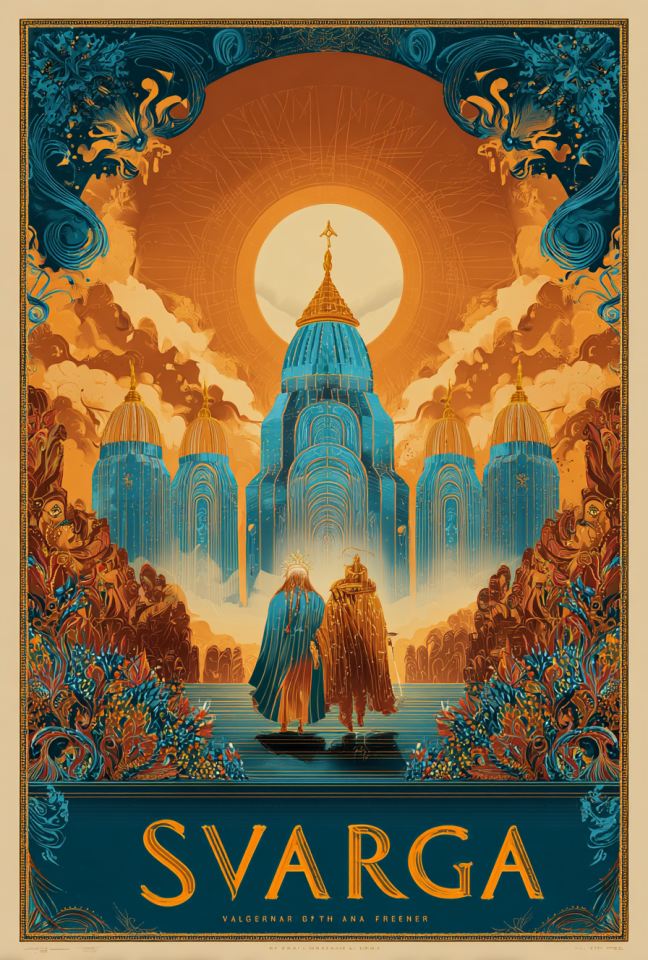Svarga is the luminous realm of divine rhythm — a radiant expanse where duty fulfilled becomes light and the souls of the virtuous are elevated into celestial refinement. It is not eternal, nor static, but rather a phase of divine resonance : a plane of reward, learning, and radiance, ruled by Indra king of the Devas. Svarga is a realm of motion within order where merit begets presence, and every pleasure holds sacred function. Here, the gods do not rest — they govern guard and witness the turning of ages. Once mirrored in Vedic temples and yogic ascent, the gateways to Svarga have since faded behind the Veil, though its echo lingers in mantra, fire, and righteous act.
Landscape and Essence
Svarga unfolds in layers of gold, thunder, and clear sky. Its air glows with internal light; the realm is neither day nor night, but an eternal brilliance that shifts in hue with divine intention. White palaces of lapis and silver drift on air-currents shaped by sacred sound. Rivers of liquid starlight wind through gardens where trees bloom with memory and music. The ground hums with dharma — law as presence — and all space moves in harmony with cosmic cycles. Time here is measured not by clocks but by sacrifice, song, and alignment. In Svarga, joy is structured; even beauty is offered with intention.
Inhabitants
Presiding over Svarga is Indra god of storms, war, and kingship — seated upon a throne of lightning and cloud, yet ever in motion. Around him dwell the Devas luminous beings of divine responsibility and cosmic stewardship: Varuna Agni Soma Vayu and others who embody elements, law, and celestial power. Apsaras and Gandharvas weave music and dance into the fabric of the realm — their art upholding cosmic rhythm. Souls of great merit from the Mortal Realm also dwell here temporarily, elevated by dharma and sacrifice, though not permanently. In Svarga, presence is earned and sustained, not granted.
Cultural Significance
In the Vedic and broader Dharmic traditions, Svarga is one of many lokas — realms of existence — situated above the earthly plane. It is not the final goal, but a reward for righteous action : the fruit of good karma, sacrifice, and alignment with sacred law. Through fire rituals (yajña), devotion, and right conduct, mortals could earn passage to Svarga. Ancient epics like the Mahābhārata and Rāmāyaṇa speak of heroes ascending to Svarga at life’s end — not for eternity, but for rest and review. In Buddhist and Jain thought, Svarga (or deva realms) also exists, but is viewed as transient — a lofty step on the wheel of rebirth. Across all traditions, it remains a place of beauty, clarity, and impermanence. With the rise of materialist philosophies and the decline of yajña-based life, the access points waned, and the Veil descended.
Role in the Divine Realm
Svarga is the court of reward and reaffirmation — the realm where the cosmos acknowledges noble effort and dharmic alignment. It is not perfection, but resonance : a place where divine law is played like music, and those in tune are invited to join the symphony. Svarga sustains the emotional and ethical balance of the Divine Realm, ensuring that merit is neither forgotten nor wasted. Its residents, divine or mortal, are actors in cosmic upkeep refining their roles before returning to deeper cycles of becoming. It is a realm of restoration, not escape.
Interactions with Other Realms
Svarga once welcomed souls through flame, prayer, and ritual — fire offerings rising like ladders of smoke. Sacred groves, mountains, and temples functioned as anchors, particularly during solstice rites or death transitions. Shamans and sages who aligned breath with mantra could sometimes glimpse it in vision. But as fire altars cooled and sacred rhythms were replaced with mechanical time, the bridge thinned. Now, only divine beings, elevated souls, or avatars may traverse freely. Still, Svarga’s presence remains in sunlit stillness, in thunder that comes without rain, and in acts of generosity that expect no return.
















